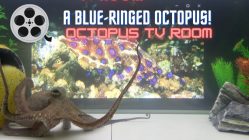—Meet the Squid—

Many of you might be more familiar with the word calamari, as the squid is popular in many cuisines around the word and its culinary name is often used to describe this amazing cephalopod. However, if you read on and find out what an extraordinary creature the squid is, you might end up seeing it less as a tasty dish and more as a potential source of enthusiasm.
What is the squid? Dah! It’s a sea animal, silly!
Yes, of course, the squid is a marine animal. But it is also:
- An invertebrate meaning that it does not possess a spine.
- A mollusc, which is a phylum of the invertebrate animals. Almost one quarter (23%) of all marine animals are molluscs. But the majority of molluscs are terrestrial organisms: 80% of all molluscs are gastropods (snails, slugs etc.) One of the main characteristics of the mollusc is the existence of a mantle cavity. The word mollusc derives from the ancient Greek word “malákia” which means soft.
- A cephalopod, which is a class of molluscs, containing also octopuses and nautiluses. They are otherwise known as inkfishes as they are all able to expel ink. The word cephalopod translates from Greek as head-feet. They are named like that to refer to their prominent heads and pairs of arms or tentacles.
- A coleoid, which is a subclass of cephalopods, only consisting of the cephalopods which have no shell, that is, the octopus, the squid, and the cuttlefish.
- A decapodiform, which is a superorder of cephalopods including cephalopods with ten feet. The word comes from Greek words (déka) meaning “ten” and (pous) meaning “foot”. The squid actually has eight arms and two tentacles
- Most squid species belong to the order of teuthida, which is the largest cephalopod order with more than 300 species classified into 29 families. The famous Bobtail Squid, for example, belongs to another order, the order of Sepiolida.
What did we learn from this short taxonomy lesson? We learned that the squid is a spineless, soft, marine creature with ten “feet”, no shell and a mantle cavity. But this short definition leaves a lot to imagination, so let’s describe the squid a bit more.
—What does the Squid Look Like?—

Why are there so many stories featuring a monstrous squid? Are they so ugly? Are they all so frightening as the notorious Giant Squid?
Most squids are about 60 cm (24 in) long. The smallest species belong to the squid genus of idiosepius, more commonly known as the Pygmy Squids, which grow to a mantle length of 10 to 18 mm (0.4 to 0.7 in). The notorious Giant Squid, on the other hand, can grow to the unbelievable length of 13 m (43 ft)!
If you think that the giant squid is enormous, wait till you hear about the recently discovered mesonychoteuthis hamiltoni, or more commonly known, the Colossal Squid. Its length is estimated to reach the length of 14 m (46ft)!
The main body of the squid looks very much like a rocket. This shape allows the squid to navigate the seas in greater speed. The head of the squid is located at the one end of the elongated body, together with its eight arms and two tentacles surrounding its mouth. The two tentacles is the longest of the five pairs of appendages. Unlike the octopus, the squid possesses two fins attached to its mantle. Similar to the octopus, the squid’s mantle also has a funnel. One main difference between the octopus and the squid is that whereas the octopus is entirely soft-bodied, the squid a small internal skeleton made of chitin, known as the gladius.
The looks of the squid are not less deceiving than those of the octopus. The squid employs two different camouflage techniques: it can change color to match is background and some squid species are also bioluminescent, an ability which they use for counter-illumination camouflage.
—Where Can I Find One?—

The squid has quite a wide distribution depending on each species. It can be found almost anywhere in the sea even though a larger number of squid is known to occur in the Pacific ocean.
There are both warm water and cold water species. The squid is very adaptive and can adjust to a new environment if its regular habitat presents a shortage of sufficient food sources.
In fact, the squid can survive and even thrives in a midwater low oxygen environment where most animals cannot.
It is generally a marine creature, although one particular squid species, known as the Brief Squid (its scientific name is Lolliguncula brevis), which can be found from the coast of New Jersey all the way down to Rio de Janeiro, shows an incredible tolerance to low saline environments unparalleled to any cephalopod. Still, squids can not survive in freshwater.
You will not easily find a squid residing at a heavily polluted region as squids appreciate clean waters.
As far as depth is concerned, whereas most squids occur at around 1.000 feet depth, there are species, like the Brief Squid mentioned above, which can appear in shallow waters, and other deep- dwelling species, such as the famous Giant Squid which is speculated to appear as deep as 1 kilometer (more than 3.200 feet!)
—Locomotion—

Squids are relatively fast swimmers. Among cephalopods squids are the strongest swimmers, mainly thanks to their shape and their incredibly strong jet propulsion.
Researchers have recently recorded the speed of “flying” squids and found it even greater than the top speed of Usain Bolt.
The squid uses a number of mechanisms to swim around the seas.
To begin with, the form of the squid itself is particularly aerodynamic. The squid can rocket its body like a torpedo by releasing the large volume of water from inside its hyper-inflated mantle cavity. Water is expelled from the funnel and up to 94% of it can be released in a single jet thrust. Squid’s jet propulsion makes them the fastest invertebrates on earth.
Flapping its fins each time the squid employs jet propulsion increases its speed to an even greater degree. The fins are then extended between each jet.
The funnel allows the squid to change its direction. Squid usually swims backwards but by adjusting the position of the funnel, it can effectively reverse its direction.
Squids also have a buoyancy chamber, which is not filled with gas like the swimming bladder of fishes or nautiloids, but instead is filled with liquid. This buoyancy chamber allows the squid to float at its desired depth.
—Flying—

Airborne squid species have been observed “flying” above the surface of the water.
The squid prepares for lift-off by inflating its mantle with water. Then, by a sudden contraction of the mantle, the water is released through the funnel, propelling the squid into the air. The water continues to be expelled while the squid is in the air and at the same time the squid glides through the air by extending its fins and expanding its tentacles. Some people claim to have seen squids actually flapping their fins while airborne.
—Hunting and Feeding—

The squid is a voracious predator. It will eat anything from fish, shrimps, crabs to other, smaller-sized squids. They will basically hunt any moving target.
Once the prey is targeted, the squid shoots out its two, long, muscular feeding tentacles, grasp the prey and bring it within arm’s reach. Some squid species have suckered arms whereas others have hooks instead of suckers. The Humbolt Squid, which is known to hunt cooperatively, has both, with the hooks concealed inside the sucker.
Once the prey is enclosed within the firm grasp of the squid’s arms, the sharp, horny beak begins to shred the prey to pieces assisted by the tongue-like radula, which is equipped with lots of tiny teeth.
In some species, the squid’s saliva contains toxins which can paralyze its prey.
Other deep-sea species use their ability to produce light as a hunting tool. The species known as the Dana Octopus Squid (Taningia danae), has been recorded in 2005 by Japanese researchers while trying to disorientate its victim. This squid has large photophores on its arms which can produce bright flashes of light that attract potential prey.
The squid is also known for having a very strong eyesight. Their large eyes enable it to detect its prey more easily. In fact, deep sea squids have a pair of differently-shaped eyes. The left eye is larger, tubular, and looks upwards, in order to spot any organism swimming higher than it. The right eye, on the other side, is smaller and can be directed forwards and downwards to detect prey.
The squid possesses another effective means of detecting pray, that is, through sound. Squids can “hear” the motion of its prey moving as motion generates sound waves. The squid can pick up these waves thanks to a couple of organs which are located near their brains called statocysts. These organs are covered with hair cells that send electric signals to the brain when a sound is detected.
Some squid species that inhabit the open sea stay below the depth of 275 meters (900) during daylight to remain hidden in the dark. As soon as it gets dark, they swim up closer to the sea surface to hunt prey such as shrimps or lantern fishes.
—Defense Mechanisms—

Squid have deadly predators such as sharks, tuna, whales, and dolphins. Luckily, they have a lot of weapons to even the fight with their lethal enemies.
The first line of defense for the squid is tracking the enemy before it gets spotted. Thanks to its large eyes and sound-detecting statocysts, they can usually spot the enemy first.
Squids, like octopuses, have the ability to camouflage to avoid detection. Besides the active camouflage, which is the camouflage applied to match the surrounding environment, some squids employ a counter-illumination camouflage. For example, the Firefly Squid and the Midwater Squid have photophores on their undersides, which produce light making them less visible to predators lurking from below.
Another defense mechanism common in all cephalopods is their ability to squirt ink. Most of the squid’s predators, such as billfishes and sharks, depend on their vision to spot their prey and the ink cloud released by the squid’s funnel can not only blind them temporarily but also confuse them. Unfortunately, it takes a few days for the squid to refill its ink sac.
A peculiar-looking deep sea squid known as the Vampire Squid, when threatened, takes up a strange posture known as the “pumpkin” or “pineapple” posture. It can turn itself inside out to hide its body by using the web between its arms as a protective cape.
A speedy retreat by jet propulsion may prove the ultimate means for a squid’s survival. It might not be as fast as a shark or a dolphin, but the squid can change its swimming direction, and move higher or deeper in the water column. It can even fly above the surface of the water to escape its mortal fate.
—Squid Species—

As the deep-sea remains widely unexplored, there is no absolute number of squid species yet. Up to the present, there are over 300 recognized squid species but researchers estimate that there might be more than 500 squid species.
Let us mention a few of them, either famous or special in some way:
- The Giant Squid and the Colossal Squid are probably the most famous and popular species due to their enormous size. They have excited the imagination since antiquity, being portrayed as monsters of the sea. They have inspired a lot of folklore tales and fiction writers and many squid enthusiasts are still devoted to the discovery of more information about these rarely-seen deep-sea residents.
- The Vampire Squid looks more like an octopus than any other species. In fact, it looks almost identical to a Dumbo Octopus.
- The Humbolt Squid is also known as the red devil, as it is an aggressive hunter that changes its color from white to red. It is reported to form groups of around 1.200 individual squids and cases of inter-species cannibalism are frequent, as well as cases of aggression towards divers.
- The Caribbean Reef Squid is known to be able to fly as long as fifty times its body length and reach a height of two meters above the sea
- Japanese Flying Squids have been observed flying in groups for distances as long as 30 meters!
- The Cock-eyed Squid exhibits a unique case of eye asymmetry, with its left eye being even twice as big as its right one!
- The Firefly Squid is bioluminescent and can possibly discriminate color as it possesses three visual pigments located in the retina.
- The female Common Clubhood Squid sheds her feeding tentacles when she reaches maturity.
- The Greater Hooked Squid has the greatest known penis length relative to body size in the animal kingdom. The erected penis has the same length as the mantle, head, and arms combined.












